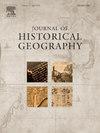灌溉周边:菲律宾的水文、殖民和反灌溉
IF 1.1
2区 历史学
Q2 GEOGRAPHY
引用次数: 0
摘要
尽管对水利基础设施在巩固边境地区权力和政治控制方面的作用进行了广泛的研究,但很少有研究考察殖民意识形态和水利基础设施如何在历史上定义领土,以控制人口、劳动力和土地使用。这篇文章探讨了西班牙是如何利用普伦萨系统——一种殖民时期的水利基础设施——来建立、维持和巩固对菲律宾的领土控制。通过水社会领土化的视角,我们展示了对水的控制如何与对土地和劳动力的控制交织在一起,从而将领土治理从马尼拉向外延伸。我们认为,普伦泽体系不仅仅是石板和混凝土;它作为一种权力工具,促进了政治、经济和意识形态的领土化,通过创建一体化区域,为更广泛的国家建设项目做出了贡献。然而,我们通过研究科迪勒拉高地的伊富高人如何通过他们的水稻梯田系统抵制国家领土化,挑战吕宋岛低地强加的国家制定工具,来强调这一水力殖民项目的局限性。本文章由计算机程序翻译,如有差异,请以英文原文为准。
Irrigating the periphery: Hydrology, coloniality and counter-irrigation in the Philippines
Despite extensive research on the role of water infrastructure in consolidating power and political control in frontier regions, few studies have examined how colonial ideologies and water infrastructures have historically defined territories to control populations, labour, and land use over time. This article explores how Spain used the prenza system–a colonial water infrastructure–to establish, maintain and consolidate territorial control in the Philippines. Through the lens of hydrosocial territorialization, we show how the control of water became intertwined with the control of land and labour, extending territorial governance outward from Manila. We argue that the prenza system was more than just slabs of stone and concrete; it functioned as an instrument of power that facilitated political, economic, and ideological territorialization, contributing to a broader state-making project by creating zones of integration. However, we highlight the limitations of this hydro-colonial project by examining how the Ifugao people of the upland Cordillera resisted state territorialization through their rice terracing system, challenging the instruments of state-making imposed in the lowlands of Luzon.
求助全文
通过发布文献求助,成功后即可免费获取论文全文。
去求助
来源期刊

Journal of Historical Geography
Multiple-
CiteScore
1.50
自引率
10.00%
发文量
53
期刊介绍:
A well-established international quarterly, the Journal of Historical Geography publishes articles on all aspects of historical geography and cognate fields, including environmental history. As well as publishing original research papers of interest to a wide international and interdisciplinary readership, the journal encourages lively discussion of methodological and conceptual issues and debates over new challenges facing researchers in the field. Each issue includes a substantial book review section.
 求助内容:
求助内容: 应助结果提醒方式:
应助结果提醒方式:


